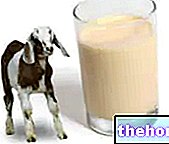The term "milk of", if referring to any product not constituted by mammary secretion, is to be considered conceptually improper.
Any possible reference in the text has the sole purpose of adapting to the terminology with which most frequently (in colloquial terms) refers to such products; therefore, it is not opposed to the current legislative framework.
What is Soy Milk
Soy milk is the name commonly attributed to a soy-based food drink, obtained by grinding or blending in water the seeds of the legume left to soak in water for a few hours.
PLEASE NOTE: according to European legislation, the term "milk" cannot be used for the marketing of vegetable drinks.
So for soy-based drinks - such as rice-based drinks etc. - the name "milk" is improper and prohibited for commercial purposes.
Not just for Vegetarians

The typical sugar of animal milks is in fact absent in soy milk, which as such represents a valid alternative for those who do not digest them.
Nutritional Properties
Beyond the organoleptic characteristics, which can be more or less pleasant according to individual preferences, soy milk has some noteworthy nutritional properties. First of all, the absence of cholesterol, which is instead present in modest quantities in cow's milk (11 mg per 100 grams for whole milk, 7 for partially skimmed and 2 for skimmed milk).
In addition to being cholesterol-free, soy milk has a lipid fraction rich in unsaturated fats (a category of health-friendly nutrients, but poorly represented in cow's milk).
From a strictly quantitative point of view, the protein intake is comparable to that of cow's milk. Thanks to the good distribution of essential amino acids, the proteins of these "yellow beans" possess a high nutritional power, which is in any case lower than that of cow's milk (the limiting amino acids of soy are sulfurates -cystine and above all methionine-). Digestion of the protein fraction is easier, on the other hand, due to the absence of the caseins typical of animal milks.
Soya also has a high content of lysine, which can complement the amino acid content of a meal based on cereals and derivatives. Soy proteins also have a further and very important advantage. Once absorbed, they act as real scavengers. arteries, significantly lowering total plasma cholesterol, LDL, triglycerides, but not the good fraction HDL, which can even be increased.
Although caution is a must when it comes to diseases with such a high social impact on the basis of statistical data not yet confirmed by a sufficient number of clinical studies, soy can help prevent colon and prostate cancer in humans. and to the breast in women. But the advantages for the female universe do not end there; soy isoflavones are in fact known as the ideal dietary supplement during menopause (they attenuate hot flashes and can contribute to the prevention of osteoporosis, overweight and hypercholesterolemia). Also in this case in the literature there are studies with conflicting results. Among many, without creating unnecessary alarmism but only to give an "idea of how delicate the issue is, there are some that underline the ability of isoflavones to promote cell growth and proliferation breast cancer. Based on the results of these studies, soy and its derivatives would be contraindicated for women with a present or past history of breast cancer.
Food
Isoflavones (tot.)
(mg / 100 g) *
mg per average serving
equivalent to (g)
Soybean seeds
58-380
34,8-228,0
Tofu
8-67
10,4-87,1
Soy flour
83-178
16,6-35,6
Soya textured protein
71-118
28,4-47,2
Soy milk
3-17
3,0-17,0
Miso
26-89
4,7-16,0
Soya cheese
3-5
1,2-20,0
Tofu yogurt
15
18,0
Soy sauce
1-7
0,1-0,3
Reinli K. And Block G. Nutr Cancer 26: 123-148
(*) Recommended intake to obtain the aforementioned therapeutic effects is between 60 and 80 mg per day
The reduced environmental impact of soy milk should also be emphasized in its favor. From the agronomic point of view, a unit of land used for the cultivation of this legume, can produce ten times more soy milk in a year, compared to that of cow's milk obtainable by foraging the cows with the grass produced by the same. moreover, soy is able to autonomously synthesize the quantities of nitrogen necessary for its metabolism, without requiring the auxiliary contribution of nitrogen fertilizers, which are instead used for the cultivation of cereals. Even for soybeans, however, there remains the need to use pesticides (herbicides and, in some cases, acaricides), which are rarely necessary in the cultivation of grazing land.
Soy Milk - How To Make It At Home
MypersonaltrainerTv's kitchen is also full of Vegan recipes. In this video our personal Cooker Alice explains how to prepare soy milk at home, a healthy alternative to cow's milk.
Homemade soy milk
Problems with playing the video? Reload the video from youtube.
- Go to the Video Page
- Go to the Video Recipes Section
- Watch the video on youtube
Alternative recipe for homemade soy milk, with hazelnut and banana
How to recover the leftover okara by preparing tasty soy meatballs. Watch the video.
Soy milk: preparation, allergies and babies "
Milk, Dairy Products and Cheeses Asiago Brie Burrata Caciocavallo Rennet Camembert Cheddar Milk Cream Crescenza Emmental Feta Milk Flakes Fontina Herbal Cheeses Lean Cheeses Cheeses rich in calcium Gorgonzola Gouda Grana Padano Gruyere Kéfalair Adapted milk Artificial milk Condensed milk Asphyxiated milk Goat's milk Sheep's milk Rice milk Soy milk Powdered milk and concentrated milk Skimmed and semi-skimmed milk Lactose-free milk Milk Vegetable milk Dairy products Lerdammer Mascarpone Montasio Buffalo mozzarella Mozzarella Whipped cream Cooking cream Fresh cream Parmigiano Reggiano Pecorino Philadelphia Primo Sale Provolone Ricotta Robiola Roquefort Scamorza Sottilette Squacquerone Taleggio Tomino Yogurt OTHER ARTICLES MILK AND DERIVATIVES Categories Alcoholic foods Meat Cereals and derivatives Sweeteners Sweets Offal Fruit Dried fruit Milk and derivatives Legumes Oils and fats Fish and fishery products Cold cuts S pezie Vegetables Health recipes Appetizers Bread, Pizza and Brioche First courses Second courses Vegetables and Salads Sweets and Desserts Ice creams and sorbets Syrups, liqueurs and grappa Basic preparations ---- In the kitchen with leftovers Carnival recipes Christmas recipes Light diet recipes Women's Day, Mum, Dad Recipes Functional Recipes International Recipes Easter Recipes Recipes for Celiacs Recipes for Diabetics Recipes for Holidays Recipes for Valentine's Day Recipes for Vegetarians Protein Recipes Regional Recipes Vegan Recipes




























